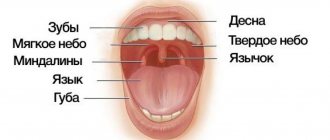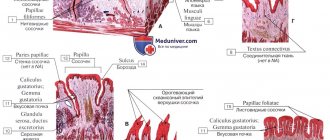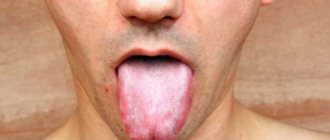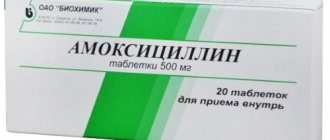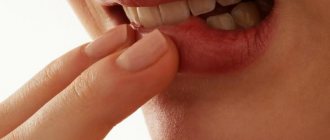A folded tongue is a congenital pathology characterized by abnormalities in the shape and size of the tongue. In approximately half of the cases, this pathology manifests itself together with desquamative glossitis. The folded tongue is also called “scrotal”. This pathology is one of the most common symptoms of Melkersson-Rosenthal syndrome.
Folded tongue: photos and symptoms
Usually the anomaly is detected in early childhood, but it also occurs in adults, since sometimes this problem does not bother the patient in any way, and the person is not even aware of its presence. The signs of the disease are as follows:
- Macroglossia, or enlargement of the tongue, which can affect a person's speech and chewing function. Usually the patient keeps his teeth in an open position.
- Folds and grooves appear on the surface, which are covered with papillae.
- The tongue is significantly thickened.
- The back and tip of the tongue are smoothed, the filiform papillae have atrophied.
- Increased sensitivity (especially in people who have undergone infectious diseases and surgical operations).
- Regular tingling and pinching sensation.
- Lymph nodes are enlarged.
- Smell from the mouth.
The folds, in turn, are different: transverse, deep longitudinal (and not very deep), fringed. Usually the main longitudinal fold (it is the largest and deepest) runs from the tip along its midline. The remaining folds lead exactly to it.
Sometimes this pathology accompanies desquamative glossitis (geographic tongue) - this is inflammation, as a result of which some areas of the organ become several shades lighter or acquire a gray tint. In general, the picture of the organ resembles a map, which is why it got its name.
What is dangerous, consequences
With proper care, the grooved tongue does not cause discomfort to the owner. Failure to comply with important points of care for a diseased organ and neglect of the disease can lead to the appearance of various infections, for example:
- Catarrh;
- Candidal glossitis;
- Phlegmon;
- Abscess;
- Hyperkeratosis.
There is also a risk of tongue cancer. Acromegaly may occur when both cheeks and tongue are folded. In case of inflammation, you need to brush your teeth very carefully so as not to touch the painful surface of the organ with the brush.
Geographic fold tongue
There is also a condition called geographic tongue (desquamative glossitis). It is characterized by the presence of reddish or gray spots on the surface. They are separated from each other by yellowish formations of thread-like nipples. Thanks to this, the organ resembles a geographical map. Often, scrotal tongue becomes one of the concomitant diseases.
Melkersson-Rosenthal syndrome
The disease presents with significant swelling of the lips and tongue, as well as facial nerve palsy. Folding is a symptom of the disease in half of the cases.
Folded tongue with white spots
White spots may be signs of concomitant pathologies. Among them:
- Desquamative glossitis;
- Melkersson-Rosenthal syndrome.
- Candidiasis glossitis.
Our team of doctors
Maxillofacial surgeon, Implantologist
Bocharov Maxim Viktorovich
Experience: 11 years
Dental surgeon, Implantologist
Chernov Dmitry Anatolievich
Experience: 29 years
Orthopedist, Neuromuscular dentist
Stepanov Andrey Vasilievich
Experience: 22 years
Endodontist, Therapist
Skalet Yana Alexandrovna
Experience: 22 years
Orthopedic dentist
Tsoi Sergey Konstantinovich
Experience: 19 years
Dentist-orthodontist
Enikeeva Anna Stanislavovna
Experience: 3 years
Hairy black tongue
Such inflammation of the tongue, as in the photo, is a consequence of the proliferation and keratinization of the papillae. The main provocateurs for the development of the disease are mechanical and chemical damage, long-term use of antibiotics, and untreated oral candidiasis. The patient with this pathology does not experience the most pleasant sensations. Firstly, filiform papillae on the mucosa can grow up to 1-2 cm in height. Secondly, the affected areas become black, which looks aesthetically unattractive and forces you to always keep your mouth shut. Plus, physical discomfort also manifests itself: most often, patients complain of vomiting and a sore throat.
The photo shows hairy black glossitis
Possible causes of pathology
The exact causes of the anomaly are unknown. But there are a number of factors that can provoke the appearance of pathology:
- chronic diseases of the liver, stomach, duodenum;
- skin diseases;
- pathologies of the nervous system;
- pathologies of the endocrine system;
- bone marrow diseases;
- acute infections;
- violation of the mucous membrane of the tongue and its trophic function;
- lack of vitamins and essential microelements in the body;
- collagenosis;
- human reaction to vaccination;
- hormonal changes (pregnancy, menopause, lactation).
Diamond tongue
The lesion is localized on the back of the organ; the tissues in this area, due to thickening of the epithelium, acquire a clearly defined oval or diamond-shaped shape. Diamond-shaped glossitis of the tongue, as in the photo, occurs chronically, but with periods of exacerbation. Often recurs. If treatment is not carried out, then neoplasms appear on the affected tissues, similar in appearance to papillomas or warts, covered with keratinized epithelium. May develop into a malignant tumor.
This is what rhomboid glossitis looks like
Treatment of folded (scrotal) tongue
The anomaly usually does not bother its owners, however, sometimes they complain about its appearance: cracks.
A folded (scrotal) tongue requires especially careful care. Because food residues may be trapped in the folds. Because of this, bad breath occurs, as well as accompanying unpleasant symptoms: burning and inflammation.
In addition, the grooves may bother people who have suffered acute infections or surgical interventions. The reasons in this case are also clear: the overall tissue reaction in the body decreases, and the sensitivity of the surface of the folded tongue increases significantly. Therefore, it reacts painfully to chemical irritants and drugs.
If the patient does not properly care for the diseased organ, then the inflammatory processes can drag on, and this is a very favorable place for the development of fungal infections.
The dentist treats this pathology. It is he who will select oral care.
Sometimes a folded tongue requires surgery. This happens in cases where the organ is too enlarged and interferes with the patient. The operation involves excision of part of it.
So, in general, drugs are used to eliminate related problems:
- Fungal and bacterial diseases: anti-inflammatory, antifungal drugs, immunocorrectors, antiseptic treatment.
- Candidiasis: clotrimazole cream, shading with aniline dyes, 10% sodium borate solution in glycerin.
- Painful sensations: antiseptic rinses, mouth baths with citral solution, application of medications with anesthesin.
Diagnostics
This diagnosis is made based on the overall clinical picture. It is important to take into account that this pathology is one of the symptoms of Melkersson-Rosenthal syndrome. This means that a folded tongue can be either a congenital or acquired pathology.
It is very important at the diagnostic stage to differentiate the pathology of the folded tongue and sclerosing glossitis, which is similar in manifestations. This change in the structure of the tongue occurs against the background of secondary syphilis. In this case, a similar structure of the tongue, resulting from an increase in the size of the connective tissue, is accompanied by compaction and decreased mobility. The folded tongue, on the contrary, is quite soft, although larger in size. There are no difficulties when chewing or speaking.
Features of care
If you have this pathology, you do not need to self-medicate; careful care and supervision by a specialist are required. In general, you should take care of your oral cavity as follows:
- general oral hygiene;
- rinsing;
- if the patient uses removable dentures, they should also be thoroughly cleaned after eating;
- it is necessary to avoid spicy, salty food, it should not be too hot or cold;
- giving up bad habits (smoking, alcohol);
- You need to brush your teeth with a special paste;
- the toothbrush should be made of synthetic materials: this will help avoid damage;
- regular visits to the dentist.
Such careful care will help neutralize the oral cavity from bacteria, which will prevent their proliferation and the occurrence of associated infections.
Author:
FAQ
How to distinguish leukoplakia from a folded tongue?
Leukoplakia has different symptoms from a grooved tongue. It should be taken into account that some of them may appear if the scrotal disease is not properly cared for.
- Inflammation and swelling of the mouth and tongue;
- Horny formations with a white coating;
- Ulcers and erosions;
- Bleeding of the affected areas;
- The mucous membrane of the mouth and tongue becomes denser and harder;
- Rapid growth of painful formations;
- Proliferation of papillae in affected areas.
Can the tongue bend poorly due to folding?
Most often, the scrotal tongue is soft and mobile. If the bending of this organ is poor, you should consult a specialist. This may be a sign of sclerosing glossitis.
Is it possible to use sea buckthorn if you have a folded tongue?
Yes, you can.
Do they die from this?
No. The main thing is to follow all the points of caring for such a tongue, otherwise other infections may arise, which can lead to very serious consequences.
Is folded tongue a disease?
Yes, this is considered a disease, but it does not threaten the owner with proper care.
Prevention
Prevention of these diseases includes several rules :
- It is necessary to provide high-quality dental care and visit the dentist in a timely manner for routine examinations and elimination of emerging problems.
- Pathologies of internal organs must be treated at the initial stages, preventing them from becoming chronic.
- You need to quit bad habits and balance your diet.
These simple rules will help you avoid inflammation of the tongue and at the same time maintain the health of the body.
If you find an error, please select a piece of text and press Ctrl+Enter.
Tags diagnostics treatment symptoms language
Did you like the article? stay tuned
Previous article
Ulcerative necrotizing gingivitis: how does it manifest itself, why is it dangerous?
Next article
What opportunities does the use of Impro implants provide?
Causes of teeth marks on the tongue
Causes of teeth marks on the tongue When diagnosing, the doctor must examine the patient’s tongue and evaluate the existing changes. One of these changes, indicating the presence of malfunctions and disorders in the body, are teeth imprints, usually on the sides of the tongue.
Teeth imprints on the tongue as a symptom of diseases of internal organs
Tooth prints are not always associated with dental problems. Changes in the tongue can cause diseases of the nervous system or gastrointestinal tract. You should not ignore the changes or try to diagnose yourself. If clear visible marks from teeth repeatedly appear on the tongue, you need to consult a doctor.
Nervous system disorders
Stress is the cause of many diseases. “Driven” inside, it can lead to serious disorders of the nervous system. One of the signs of constant, prolonged stress is the visible imprints of teeth on the tongue. During times of nervous tension, the jaws involuntarily close tightly, which leads to the appearance of teeth marks that remain for a long time.
If this happens once, the imprint will quickly pass, but a protracted process indicates a worsening of problems with the nervous system. In such cases, there is no need to take risks. You need to contact a neurologist who will treat the nervous system. As the underlying disease is cured, the tooth marks will also disappear.
Endocrine system diseases
Hormonal imbalances can externally manifest themselves with different symptoms. For example, hypothyroidism (thyroid disease associated with iodine deficiency) is often diagnosed after a patient complains of hair loss and brittleness or splitting nails. As the disease progresses, swelling of the face and neck appears. The tongue swells and increases in size, and marks begin to remain on its surface. The complex of symptoms indicates that it is necessary to visit an endocrinologist.
Another common endocrine disorder is xerostomia. As this disease develops, the salivary glands stop working properly. The oral mucosa becomes dry, the tongue becomes crimson in color, and tooth marks are visible on its surface. Patients often complain that they cannot taste food while eating.
There are many reasons why the salivary glands malfunction. You cannot self-medicate. Usually, making a correct diagnosis requires examination not only by an endocrinologist, but also by other specialists. Diseases of the gastrointestinal tract
Disturbances in the gastrointestinal tract always lead to changes on the surface of the tongue. Plaque, swelling, teeth marks are a reason to visit a gastroenterologist. Especially if you know that you have such diseases. It is pointless to treat only fingerprints. Until the underlying disease is cured, the problem will not be solved. External symptoms disappear on their own after the condition stabilizes.
If you have a problem similar to that described in this article, be sure to contact our specialists. Don't diagnose yourself!
Why you should call us now:
- We will answer all your questions in 3 minutes
- Free consultation
- The average work experience of doctors is 12 years
- Convenient location of clinics
Single contact phone number: +7
Make an appointment
Dental Causes of Tooth Marks
The most common dental cause of teeth marks is malocclusion. Depending on the type of malocclusion, the imprints are localized on one or both sides of the tongue, sometimes located closer to the tip or, conversely, to the root. The appearance of marks is due to the fact that with an incorrect bite, when closing the jaws, the tongue tries to take a position corresponding to the location of the dentition.
In this case, orthodontic treatment is prescribed. The method of exposure is selected by the doctor depending on the type and severity of the pathology. You can treat malocclusion at any age, but it is better to do it in childhood, immediately after all the baby teeth have erupted. Glossitis
Glossitis is a disease that leads to inflammation of the tongue. Its surface becomes smooth, as if glossy, the papillae are smoothed out, and noticeable teeth marks appear on the side parts. Glossitis is usually accompanied by painful sensations. Erosion may develop on the oral mucosa. Patients complain of an unpleasant odor.
In the early stages, the disease manifests itself with slight pain and burning. As it develops, deep foci of erosion may develop on the mucous membrane, and it becomes difficult for the patient to eat. At this stage, signs of general malaise are added to the main symptoms. The temperature rises, weakness and lethargy appear. Only a doctor can prescribe adequate treatment.
The cause of the appearance of fingerprints can also be congenital pathologies. In any case, if you begin to notice changes on the surface of your tongue, you need to consult a doctor. Sometimes a diagnosis may require examination by several specialists. The underlying disease must always be treated. After this, the prints pass through.
